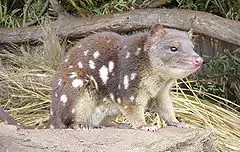| Dasyurinae | |||||
| Goldfuss, 1820[1] | |||||
 Przedstawiciel podrodziny – niełaz wielki (Dasyurus maculatus) | |||||
| Systematyka | |||||
| Domena | |||||
|---|---|---|---|---|---|
| Królestwo | |||||
| Typ | |||||
| Podtyp | |||||
| Gromada | |||||
| Podgromada | |||||
| Rząd | |||||
| Rodzina | |||||
| Podrodzina |
niełazy | ||||
| Typ nomenklatoryczny | |||||
|
Dasyurus É. Geoffroy Saint-Hilaire, 1796 | |||||
| |||||
| Rodzaje | |||||
| |||||
Niełazy[18] (Dasyurinae) – podrodzina ssaków z rodziny niełazowatych (Dasyuridae).
Występowanie
Podrodzina obejmuje gatunki występujące w Australii, Indonezji i na Nowej Gwinei[19][20].
Podział systematyczny
Do podrodziny należą następujące występujące współcześnie rodzaje[21][19][18]:
- Dasycercus W. Peters, 1875 – mulgara
- Dasyuroides W.B. Spencer, 1896 – kowari – jedynym żyjącym współcześnie przedstawicielem jest Dasyuroides byrnei W.B. Spencer, 1896 – kowari pustynny
- Dasykaluta Archer, 1982 – kaluta – jedynym przedstawicielem jest Dasykaluta rosamondae (Ride, 1964) – kaluta ruda
- Parantechinus Tate, 1947 – sorkołaz – jedynym przedstawicielem jest Parantechinus apicalis (J.E. Gray, 1842) – sorkołaz okularowy
- Myoictis J.E. Gray, 1858 – szczurołaz
- Pseudantechinus Tate, 1947 – niełazik
- Neophascogale Stein, 1933 – górołaz – jedynym przedstawicielem jest Neophascogale lorentzi (Jentink, 1911) – górołaz szponiasty
- Phascolosorex Matschie, 1916 – ryjkołaz
- Dasyurus É. Geoffroy Saint-Hilaire, 1796 – niełaz
- Sarcophilus F. Cuvier, 1837 – diabeł – jedynym żyjącym przedstawicielem jest Sarcophilus harrisii (Boitard, 1841) – diabeł tasmański
Opisano również rodzaj wymarły[22][23]:
- Archerium Wroe & Mackness, 2000 – jedynym żyjącym przedstawicielem był Archerium chinchillaense Wroe & Mackness, 2000
- Whollydooleya Archer, Christmas, Hand, Black, Creaser, Godthelp, Graham, Cohen, Arena, Anderson, Soares, Machin, Beck, L.A.B. Wilson, Myers, Gillespie, Khoo & Travouillon, 2016
Uwagi
Przypisy
- ↑ G.A. Goldfuss: Handbuch der Zoologie. Cz. 2. Nürnburg: Johann Leonhard Schrag, 1820, s. 447. (niem.).
- ↑ J.E. Gray. An Outline of an Attempt at the Disposition of Mammalia into Tribes and Families, with a List of the Genera apparently appertaining to each Tribe. „Annals of Philosophy”. New Series. 10, s. 340, 1825. (ang.).
- ↑ G.T. Burnett. Illustrations of the Quadrupeda, or Quadrupeds, being the arrangement of the true four-footed Beasts indicated in outline. „Quarterly Journal of Science, Literature, and Art”. 28, s. 353, 1830. (ang.).
- ↑ R. Owen. Outlines of a Classification of the Marsupialia. „Proceedings of the Zoological Society of London”. 7, s. 19, 1839. (ang.).
- ↑ G.R. Waterhouse: Mammalia. Marsupialia or Pouched Animals. W: W. Jardine: The Naturalist’s Library. Cz. 24. Edinburgh: W. H. Lizars, 1841, s. 60. (ang.).
- ↑ R.-P. Lesson: Nouveau Tableau du Règne Animal: Mammifères. Paris: Arthus Bertrand, 1842, s. 190. (fr.).
- ↑ P. Gervais: Histoire naturelle des mammifères: avec l’indication de leurs moeurs et de leurs rapports avec les arts, le commerce et l’agriculture. II. Carnivores, proboscidiens, jumentés, bisulques, édentés, marsupiaux, monotrèmes, phoques, sirénides et cétacés. Paris: L. Curmer, 1855, s. 280. (fr.).
- ↑ J. van der Hoeven: Handbook of zoology. Cz. 2: Vertebrate animals. Cambridge: University Press, 1858, s. 619. (ang.).
- ↑ E. Haeckel: Generelle morphologie der organismen. Allgemeine grundzüge der organischen formen-wissenschaft, mechanisch begründet durch die von Charles Darwin reformirte descendenztheorie. Cz. 2. Berlin: G. Reimer, 1866, s. clvii. (niem.).
- 1 2 T.N. Gill. Arrangement of the Families of Mammals; with Analytical Tables. „Smithsonian Miscellaneous collections”. 11, s. 26, 1872. (ang.).
- ↑ O. Thomas: Catalogue of the Marsupialia and Monotremata in the collection of the British Museum (Natural History). London: The Trustees, 1888, s. 254. (ang.).
- ↑ H. Winge: Jordfundne og nulevende pungdyr (Marsupialia) fra Lagoa Santa, Minas Geraes, Brasilien: med udsigt over pungdyrenes slægtskab. Kjøbenhavn: F. Dreyer, 1893, s. 88, 93. (duń.).
- ↑ G.G. Simpson. Post-Mesozoic Marsupialia. „Fossilium catalogus 1. Animalia”. 47, s. 9, 1930. (ang.).
- 1 2 H. Moeller. Zur kenntnis der schnädelgestalt groBer Rabbeutler (Dasyuridae Waterhouse, 1838) eine allometrische formanalyse. „Zoologische Jahrbücher: Abteilung für Systematik, Ökologie und Geographie der Tiere”. 91 (2), s. 300, 1973. (niem.).
- ↑ Archer 1982 ↓, s. 438.
- ↑ Archer 1982 ↓, s. 439.
- ↑ M. Archer. Emendations to the nomenclature of recently established palaeontological taxa. „Australian Zoologist”. 25 (3), s. 67, 1989. (ang.).
- 1 2 Nazwy polskie za: W. Cichocki, A. Ważna, J. Cichocki, E. Rajska-Jurgiel, A. Jasiński & W. Bogdanowicz: Polskie nazewnictwo ssaków świata. Warszawa: Muzeum i Instytut Zoologii PAN, 2015, s. 6, 7. ISBN 978-83-88147-15-9. (pol. • ang.).
- 1 2 C.J. Burgin, D.E. Wilson, R.A. Mittermeier, A.B. Rylands, T.E. Lacher & W. Sechrest: Illustrated Checklist of the Mammals of the World. Cz. 1: Monotremata to Rodentia. Barcelona: Lynx Edicions, 2020, s. 60–62. ISBN 978-84-16728-34-3. (ang.).
- ↑ D.E. Wilson & D.M. Reeder (red.): Tribe Dasyurini. [w:] Mammal Species of the World. A Taxonomic and Geographic Reference (Wyd. 3) [on-line]. Johns Hopkins University Press, 2005. [dostęp 2020-10-22].
- ↑ N. Upham, C. Burgin, J. Widness, M. Becker, C. Parker, S. Liphardt, I. Rochon & D. Huckaby: Treeview of Mammalian Taxonomy Hierarchy. [w:] ASM Mammal Diversity Database (Version 1.12) [on-line]. American Society of Mammalogists. [dostęp 2024-01-06]. (ang.).
- ↑ S. Wroe & B.S. Mackness. A new genus and species of dasyurid from the Pliocene Chinchilla Local Fauna of south-eastern Queensland. „Alcheringa”. 24 (4), s. 320, 2000. DOI: 10.1080/03115510008619535. (ang.).
- ↑ M. Archer, O. Christmas, S.J. Hand, K.H. Black, P. Creaser, H. Godthelp, I. Graham, D. Cohen, D.A. Arena, C. Anderson, G. Soares, N. Machin, R.M. Beck, L.A.B. Wilson, T.J. Myers, A.K. Gillespie, B. Khoo & K.J. Travouillon. Earliest known record of a hypercarnivorous dasyurid (Marsupialia), from newly discovered carbonates beyond the Riversleigh World Heritage Area, north Queensland. „Memoirs of Museum Victoria”. 74, s. 138, 2016. (ang.).
Bibliografia
- M. Archer. Review of the dasyurid (Marsupialia) fossil record, integration of data bearing on phylogenetic interpretation, and suprageneric classification. „Carnivorous Marsuliaps”. 2, s. 397–443, 1982. (ang.).
Identyfikatory zewnętrzne (takson):
This article is issued from Wikipedia. The text is licensed under Creative Commons - Attribution - Sharealike. Additional terms may apply for the media files.